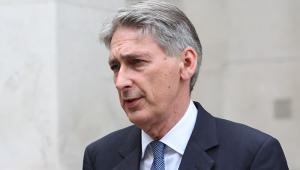The nationalisation of Northern Rock feels like a momentous event, and politically it undoubtedly is. But when it comes to the impact on the Treasury's fiscal rules, 'temporary public ownership' actually changes very little. A more significant happening, the death of the government's cherished sustainable investment rule, took place a few days earlier.
Even before the 'N' word was finally spoken, the writing was on the wall for the rule: the one that says net public debt must stay below 40% of GDP. The Office for National Statistics had already ruled that Northern Rock and the Bank of England must be classified as part of the public sector, putting £100bn of potential Northern Rock liabilities on to the government's balance sheet.
Suddenly the public sector net debt figure has jumped to about 45% of GDP, according to the calculations of the Institute for Fiscal Studies. But even if Northern Rock had not been counted against the public sector, Chancellor Alistair Darling would have needed to raise taxes by about £8bn in next month's Budget to live within the sustainable investment rule, says the IFS.
'Whether or not tax and spending plans will need to change should depend only on the long-term impact of Northern Rock on public sector net debt, which remains uncertain,' says Robert Chote, director of the IFS. He argues that while the big increase in net debt is embarrassing for the prime minister, most, and possibly all, of the effect will be temporary.
However, there are other pressures on the sustainable investment rule. Tax revenues are likely to fail to meet Treasury projections as the economy slows – and the chancellor will be tempted to increase borrowing to cover the deficit, as an alternative to unpopular tax increases. In any case, the net debt is expected to rise further and substantially when Private Finance Initiative liabilities move on to the balance sheet in the new financial year, as part of the adoption of International Financial Reporting Standards.
But it is not only the sustainable investment rule that is feeling the credit crunch. The impact is being felt widely across the public sector, not least in deficits in funded pension schemes. Local government pension scheme advisers Hymans Robertson say that council schemes lost 6% in value between the end of December and the end of January – equivalent to all the gains they made last year. Reductions in the long-term interest rates on the capital markets – themselves brought on by the financial crisis – exacerbated the problem by increasing scheme liabilities. Taken together, the double whammy has reduced the funding level of schemes by around 10%.
Emily McGuire, head of the local government investment team at Hewitt Associates, which also specialises in advising council schemes, argues that a lot of funds have protected themselves from stock market volatility by increasing diversification, particularly through hedge funds, which can perform well when equity values fall. Pension funds have also diversified into commercial property, both in the UK – where values have dropped badly – and in continental Europe – where values have held up better.
'Some funds have been well positioned, especially those that are risk-diverse, which should stand up reasonably well,' she says.
The credit crunch is likely to affect local government in another way too. As bad debts are often one of the first symptoms of a worsening economy, councils could have greater problems collecting council tax. This reflects not just the general economic climate, but the tougher credit conditions – and even withdrawal of credit cards – now being imposed by some lenders.
Philip King, director general of the Institute of Credit Management, says: 'I think they [bad debts] will increase as a result of the reduced availability of alternatives for people. Credit card issuers are reducing credit limits, so consumers who are struggling will find that options no longer exist. It will precipitate some bad debts that otherwise would have dragged on longer. I can't predict a figure, but I do think there will be a fundamental increase, because there is a [high] level of the population who are struggling.'
With the threat of declining revenues, public sector capital programmes are put at risk – particularly those financed by the PFI. Building Schools for the Future, a potentially £33bn, 15-year programme to replace or modernise all English secondary schools, has been criticised for its slow progress. David Cooper, head of PFI and structured project finance at Barclays Commercial Bank, fears that the Treasury's tax deficit could provoke further delays in the BSF, though he concedes there is no evidence as yet of this happening. 'It may slow down,' he says.
Cooper also complains that plans to expand the use of the PFI for social housing and regeneration are proving slow to realise.
While there is an impact on the demand side, the biggest effect on capital spending comes from the supply side. Bradford & Bingley, a specialist financial services institution, has already withdrawn from the market for lending to housing associations. It sold its social housing loan portfolio to Dexia, the European banking group that specialises in local public sector funding. Some other public sector specialist lenders have responded to the crisis by raising their prices to uncompetitive levels, and there are doubts about the ability of some to stay active in the market.
As the number of banks willing to lend into the PFI market declines, so the cost of financing has increased. Mike Chappell, head of project finance at Lloyds TSB, explains: 'Pricing, particularly for the PFI market of up to £100m deals, was too low.'
He argues that the market had priced PFI projects as if they were government risk, when real risk was being taken by the lender. Banks are now redressing what they regard as that pricing imbalance, while also reflecting the reduced number of lenders in the market. 'The current market dislocation has resulted in some institutions having limited appetite – or, indeed, capital – for a significant debt commitment to a PFI project,' says Chappell. 'This could result in some banks withdrawing from the market, reducing liquidity further.'
The ripples of the sub-prime crisis, though, go much further than the banks, with a potentially dire effect on the whole PFI and public-private partnership sector. Bond insurers – the so-called 'monolines' (because they offer no other insurance products) – have been rocked by their exposure to US sub-prime mortgages. Ambac, MBIA and other monolines guarantee bonds to raise their credit status to triple-A+ investment grade. Traditionally, the role of the monolines was to guarantee municipal bonds, particularly in the US. But in recent years they have extended their reach, guaranteeing sub-prime mortgages in the US – and many PFI and PPP schemes.
The role of the monolines in the PFI sector is not well understood, but it has been significant. Many of the largest schemes have been financed with the backing of the bond insurers. Ambac guaranteed half a billion pounds on the Barts and Royal London hospitals PFI project; £730m on the Allenby & Connaught Ministry of Defence accommodation PFI scheme; £580m on Colchester Barracks; and £356m for a new hospital campus in Manchester. MBIA guaranteed £600m for the National Air Traffic Services PPP and also backed bonds on the Allenby & Connaught project.
For the time being at least, this type of involvement is over. The US sub-prime crisis has had a major impact on the monolines, exposing them to potentially vast liabilities and possibly threatening the solvency of some of them. The ratings agencies Standard & Poor's, Moody's and Fitch have indicated that they are keeping careful watch over several monolines and have begun downgrading them: Fitch cut Ambac from triple-A to double-A. Both MBIA and Ambac intend to raise fresh capital to protect their ratings.
The good news for those who have already issued bonds guaranteed by a monoline is that if one did go down, the hit would be taken by investors, not the public sector client.
Without a triple-A rating, the monolines cannot offer value to PFI schemes. And without a monoline 'wrap', the PFI bond market is barely alive. A few monolines have avoided exposure to sub-prime loans, but they cannot take up all the slack in the market and their prices have now risen so that bonds have ceased to be competitive against bank loans. The market consensus is that it will take at least six to nine months for the PFI bond market to recover.
The most immediate impact is felt on the MoD's £13bn Future Strategic Tanker Aircraft PFI contract, to replace the RAF's fleet of VC10 and TriStar aircraft. This is one of the largest-ever PFI deals, in which monolines were expected to guarantee between £2.5bn and £6.5bn of debt. It now looks as if bank loans will replace the bonds. The FSTA contract should still go ahead, but at slightly higher cost, according to one person close to the negotiations. The sector hopes that finalisation of the FSTA will boost confidence for future PFI deals.
Mike Harlow, a partner at KPMG, concedes that there is now uncertainty hanging over the PFI and PPPs, but hopes that in the second half of this year the bond insurers will recover their stability and credit ratings and be back in the market place.
'The question mark is what capacity there is in the market,' he says. Given that it takes a long time for deals to flow through to closure, that is unclear at present. Harlow says that he has been involved in closing three deals in the £100m to £300m range in recent weeks 'and in each case there was a difficulty, either with increased costs, or with banks bringing in partners'.
But, he adds, 'There is still plenty of bank capacity for well-structured deals and, importantly, due to a reduction in bank swap rates since summer 2007, the underlying cost of debt for PFI deals is now lower than it was pre-credit crunch. My view is that the credit crunch has little impact on well-structured PFI deals getting done, but it should throw up greater opportunity for these deals to be refinanced once credit markets return to normal.'
Yet, despite this optimism, the structure of PFI deals is changing as a result of the global financial crisis, and not only because loans are replacing bonds. Traditionally, a PFI deal involves one or two 'lead' banks that lend upfront and then 'syndicate' the loan across other banks after closure. However, the near collapse of Northern Rock illustrated the problems with the inter-bank lending market and banks are no longer willing to risk facing difficulties with syndication after deal completion.
Consequently, public sector clients must now expect – at least for the next few months – to deal with several banks prior to deal closure. Where in the past they might have dealt with one or two, now they must expect to negotiate with five or six. In effect, loan syndication is taking place before deal closure, instead of afterwards.
The result can be a more difficult process for clients, with each bank having slightly different requirements that have to be met.
Problems with syndication are also leading to greater use of 'market flex' clauses. These allow funding banks limited flexibility to change the price, terms and/or structure of loans, transferring some of the risk attached to market uncertainty and adverse changes in rate conditions from the lender to the borrower.
While some PFI and PPP projects will be delayed and a few might be cancelled, there is unlikely to be any serious disruption of their use. Public sector clients have no real alternative for most major capital projects, they are low-risk loans for banks and there is a high level of underlying demand for them as investments within the portfolios of pension schemes and long-term funds.
'Banks are very committed to the sector, with good pricing,' says Paul Davies, a partner with PricewaterhouseCoopers. 'But I would not pretend that all banks are as hungry as before. There is a greater diversity of responses now. The art is knowing which banks will be the most competitive.'
Underlying everything is a fog of uncertainty. The use of 'financial engineering' and the complex hedging of financial risk means there is very real confusion about exactly who has lost what from the sub-prime crisis – and that is affecting almost everything on the world's financial markets. Quite simply, many (perhaps most) banks do not yet properly understand their own capital positions, or level of exposure to sub-prime loans.
If, as many expect, more European banks are forced to make much larger write-downs, the credit vice could tighten – not just on domestic borrowers, but also in the PFI market, where these very same banks are among the largest lenders.
PFfeb2008



















